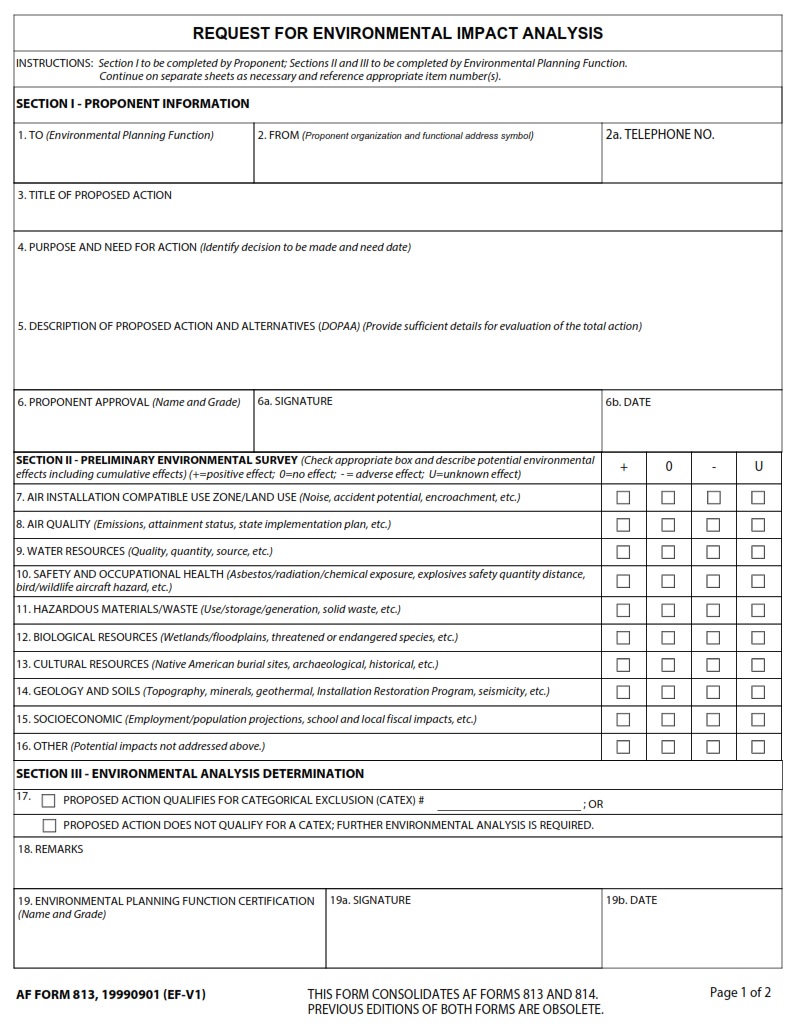AF-FORMS.COM – AF Form 813 – Request For Environmental Impact Analysis – Are our military operations harming the environment? When it comes to conducting military activities, understanding the potential environmental impact is crucial. The AF Form 813 – Request For Environmental Impact Analysis plays a pivotal role in ensuring that the United States Air Force takes into account the ecological consequences of its undertakings. From training exercises to construction projects, this form serves as a gateway for identifying and assessing the potential effects on natural resources, wildlife habitats, and air and water quality. In this article, we will delve into the significance of AF Form 813, exploring its purpose, components, and how it contributes to sustainable military practices that prioritize environmental preservation alongside national defense efforts.
Download AF Form 813 – Request For Environmental Impact Analysis
| Form Number | AF Form 813 |
| Form Title | Request For Environmental Impact Analysis |
| Edition Date | 9/1/1999 |
| File Size | 1 MB |
What is an AF Form 813?
The AF Form 813, also known as the Request for Environmental Impact Analysis, plays a crucial role in the United States Air Force’s commitment to environmental stewardship. This form is utilized to assess the potential impact of proposed projects or activities on the environment and ensure compliance with relevant regulations. It serves as a proactive tool to identify and mitigate any adverse effects that could arise from Air Force operations, contributing to sustainable practices and responsible decision-making.
Every AF Form 813 submission undergoes a comprehensive review process, involving multidisciplinary expertise and attention to detail. The analysis encompasses various aspects such as air quality, water resources, cultural resources, and natural habitats. By systematically evaluating these factors, the Air Force can make informed choices that minimize ecological harm while meeting operational needs. Ultimately, the AF Form 813 embodies a proactive approach toward environmental management within military operations, reflecting an evolving awareness of conservation principles in defense planning.
Where Can I Find an AF Form 813?
If you’re wondering where to find an AF Form 813, look no further than the official Air Force e-Publishing website. The form can be easily accessed and downloaded in a few simple clicks. Additionally, many Air Force installations and environmental offices also have physical copies available for personnel who may need them.
Moreover, it’s worth noting that the accessibility of AF Form 813 reflects the Air Force’s commitment to environmental stewardship and compliance. By making the form readily available, the Air Force demonstrates its dedication to ensuring that all potential environmental impacts are thoroughly assessed and mitigated. This proactive approach underscores the importance of taking environmental concerns seriously in military operations, setting a positive example for other organizations to follow.
AF Form 813 – Request For Environmental Impact Analysis
The AF Form 813, Request for Environmental Impact Analysis, plays a crucial role in assessing and mitigating the environmental impact of Air Force activities. This form serves as the initial step in identifying potential environmental consequences of proposed projects and activities, ensuring that necessary measures are taken to minimize any negative effects. By requiring thorough analysis and documentation, this form reflects the Air Force’s commitment to responsible environmental stewardship.
Submitting an AF Form 813 demonstrates the Air Force’s dedication to transparency and accountability in managing its ecological footprint. It serves as a tool for promoting sustainable practices within military operations, highlighting the organization’s recognition of its responsibility to safeguard natural resources and minimize adverse impacts on surrounding ecosystems. Moreover, this process emphasizes the importance of considering environmental factors when making operational decisions, fostering a culture of holistic planning that integrates both mission requirements and conservation efforts.

